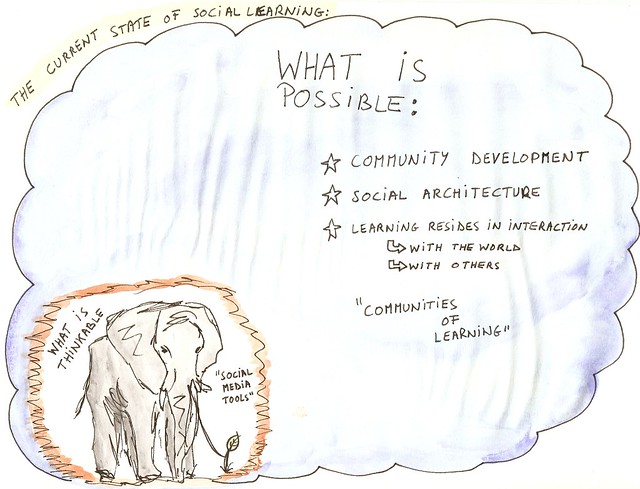Do you know the story of the elephant and the twig? It’s the tragedy of social learning today: what is possible is not thinkable.
It’s kind of difficult to plough through the clutter about social media and the stories of how it is supposed to reshape the way we are doing things today. The noise of the circus is getting so loud that nobody notices that we are almost stopped moving . The louder people are shouting, the less things seem to evolve.
One area in particular where this seems to be true is the area of ‘social learning’. I am referring to the term that is currently being used to overhaul the good old term ‘knowledge management’ and the fun way to pimp training sessions with ‘new learning tools’.
Some time ago I argued that training is the unnatural de-contextualization of knowledge so it can fit into the context of multiple participants. That way we can model schools like a factory. People can be trained in batches and outputs can be measured. This is where we are today – and this is where the so-called ‘social learning’ gets stuck.
Learning has a different disposition. It is contextual in nature. It is the problem at hand, the challenge in front of you and the unresolved tension you are coping with that triggers the intention to learn. Most of all, learning is a social thing. The most important part of learning is adopting a way of seeing, a way of engaging and a way of knowing.
The only way to sense if a problem is an interesting problem or to know if a solution is an elegant solution is by participating in the practices of a field. Therefore, the question of learning is one of participation. John Seely Brown refers to this as enculturation.

Social Learning is not the same as the use of social media in the classroom. The emphasis should be on the “social” here, i.e.: on the possibility of community that is embedded in the use of these platforms. It’s always about the community and learning-to-be. The point I’m trying to make is that social media platforms are enabling communities of practice to become learning centers of gravity. This means that the classroom is no longer the point of gravity for learning to occur, it’s merely one of the many instances in which learning can become concrete.
Then what, you may ask, is holding us back from doing just that? Well, do you know the story of the elephant and the twig? Young elephants are trained by being tied to an unmovable object, like a tree. The elephant tries to break away, until it eventually gives up. When the elephant grows to be an adult, it can be tied to a twig – because it won’t try to escape.
The classroom is the twig that limits us from seeing the real potential of social media for learning. As long as we see the classroom as the center of gravity for learning our interpretation of what social learning can do for us will limited to ‘fancy learning tools for the classroom’. The result is that 99% of what is possible through social media (i.e.: community development which is the essence of learning-to-be) is not yet thinkable because of our twig-mindset.
No we don’t need a newer version of our device. We need an upgrade of our perception.



Pingback: Where Social Learning is Stuck Today | Reply-MC | Organization Survival Playbook | Scoop.it()
Pingback: Getting Serious about Community Development (Part 5) | Reply-MC()